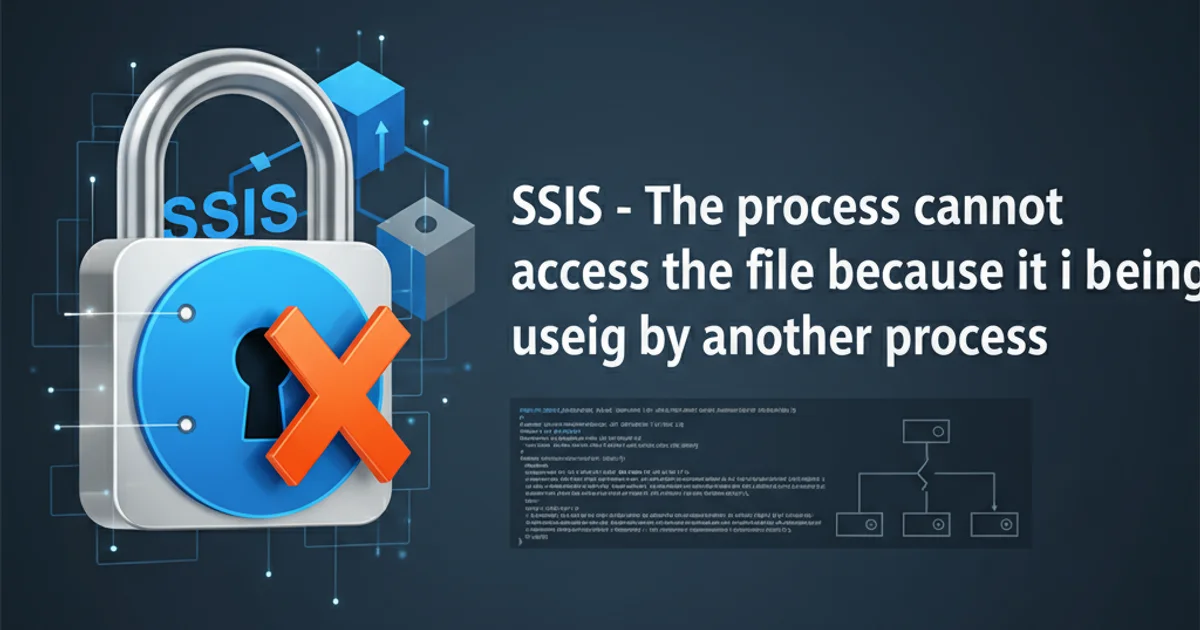SSIS - The process cannot access the file because it is being used by another process
Categories:
Resolving 'The process cannot access the file because it is being used by another process' in SSIS

Understand and troubleshoot the common 'file in use' error in SQL Server Integration Services (SSIS) packages, with practical solutions for various scenarios.
The error message "The process cannot access the file because it is being used by another process" is a common frustration for developers working with SQL Server Integration Services (SSIS) packages. This issue typically arises when an SSIS package attempts to read from or write to a file that is currently locked by another application, another SSIS component, or even the same component in a previous, unreleased state. This article will delve into the root causes of this problem and provide comprehensive strategies to diagnose and resolve it, ensuring your SSIS packages run smoothly.
Understanding the Root Cause
At its core, this error is an operating system-level issue. When a process opens a file, it often acquires a lock to prevent other processes from modifying or reading it simultaneously, which could lead to data corruption or inconsistent states. SSIS packages, being a collection of tasks that interact with various data sources and destinations, frequently encounter this when dealing with flat files, Excel files, or even temporary files generated during execution. The challenge lies in identifying which process holds the lock and why it's not releasing it in a timely manner.
flowchart TD
A[SSIS Package Execution] --> B{Attempt File Access}
B --> C{Is File Locked?}
C -->|Yes| D["Error: File in Use"]
C -->|No| E[Successful File Access]
D --> F{Identify Locking Process}
F --> G{Implement Solution}
G --> AFlowchart illustrating the 'file in use' error scenario in SSIS
Common Scenarios and Solutions
The 'file in use' error can manifest in several ways within SSIS. Understanding the context helps in applying the correct solution.
Scenario 1: File Locked by Another Application or User
This is perhaps the most straightforward scenario. Another program (e.g., Excel, Notepad++, an antivirus scanner) or a user has the file open. SSIS cannot access it until that external lock is released.
1. Identify the Locking Process
Use tools like Resource Monitor (resmon.exe) or Process Explorer (from Sysinternals) to identify which process has a handle on the file. In Resource Monitor, go to the CPU tab, expand 'Associated Handles', and search for the file path. Process Explorer allows you to search for a handle or DLL substring.
2. Close the Locking Application
If it's a user application, simply close it. If it's a background process, evaluate if it can be temporarily stopped or configured to release files more quickly.
3. Implement Retry Logic (SSIS)
For transient locks, add retry logic to your SSIS package. This involves placing the file access task (e.g., Data Flow Task, File System Task) inside a For Loop Container or Foreach Loop Container with a delay and a maximum number of retries. This allows the package to wait for the lock to be released.
Scenario 2: File Locked by SSIS Itself (Previous Task or Component)
This is a common and often overlooked cause. An SSIS task might open a file, but due to an error or improper configuration, it fails to close the file handle before a subsequent task tries to access it. This can happen with Flat File Connection Managers, Excel Connection Managers, or even Script Tasks that don't explicitly close file streams.
Script Tasks for file operations. Always ensure that StreamReader or StreamWriter objects are properly disposed of using using blocks or explicit Close() calls.using System.IO;
public void Main()
{
string filePath = Dts.Variables["User::FilePath"].Value.ToString();
// Correct way to ensure file handle is released
using (StreamReader sr = new StreamReader(filePath))
{
string line;
while ((line = sr.ReadLine()) != null)
{
// Process line
}
}
Dts.TaskResult = ScriptResults.Success;
}
Example of proper file handling in a C# Script Task using a using block
Scenario 3: Antivirus Software Interference
Antivirus software can sometimes scan files just as SSIS is trying to access them, causing a temporary lock. This is particularly prevalent with newly created or modified files.
1. Exclude SSIS Working Directories
Configure your antivirus software to exclude the directories where SSIS packages store temporary files or process input/output files. This is a common practice in production environments.
2. Schedule Antivirus Scans
Ensure that scheduled antivirus scans do not coincide with critical SSIS package execution times.
Scenario 4: Incorrect Connection Manager Configuration
Sometimes, the way a Flat File Connection Manager or Excel Connection Manager is configured can contribute to locking issues, especially when dealing with multiple files or dynamic file paths.
Ensure that connection managers are properly configured, especially when using expressions for file paths. If a connection manager is initialized with an invalid path or tries to access a non-existent file, it might still hold a handle or cause unexpected behavior that leads to locks.
Foreach Loop Containers to process multiple files, ensure that the DelayValidation property of the Data Flow Task and relevant Connection Managers is set to True. This prevents SSIS from trying to validate file paths before the loop provides a valid one, reducing potential locking issues or errors.